How are amps worked out? How do you know which fuse to put in? What are kilowatts? What part do volts play? Just a few questions we get asked at DIY Doctor and if you ever need to do any electrical work, it’s essential that you have an understanding of what all of this means.
In this project we take a look at the different types of electrical measurement, how they relate to each other and why they’re important.
What are Amps?
In basic terms, an amp, short for ampere is a unit of electrical current and is used to measure the amount of electrical current running around a circuit.
In essence, it’s the speed or rate that electricity flows around a given circuit, or to be more specific, the volume of electrons flowing through wire etc. The larger the amount of amps, the greater the amount of electricity can flow.
This is most relevant in your home when it comes to your socket and lighting circuits. As lighting requires less electricity to function due to the fact bulbs and the likes don’t use much electricity, they generally run on a 6 amp circuit and only need 1 – 1.5mm2 cable.
However, for larger appliances that need a great deal of electricity to work such as an oven, they will have their own dedicated 30 amp circuit and generally use at least 6mm2 (sometimes 10mm2) cable as the amount of electricity needed to make them work is much more so the draw is much greater.
A good way to imagine this is water flowing through a pipe. If the pipe is large a great deal of water can flow and the resistance is much less, but when trying to force the same amount of water through a pipe half the size, the resistance is much greater and much more pressure is needed and with pressure comes heat!
So with this in mind, if an appliance tries to draw too much electricity in one go this can cause everything to over heat and potentially catch fire!
To counteract any such issues, fuses are placed in a circuit to act as a weak point as they are designed to melt first before anything else and also the correct size cable for the items you’re powering needs to be used.
If the current flowing through a cable is too great for either the size of the cable, or the appliance it is feeding, something has to give. The idea is the fuse goes first. Ergo, it’s absolutely essential the right fuse is used!
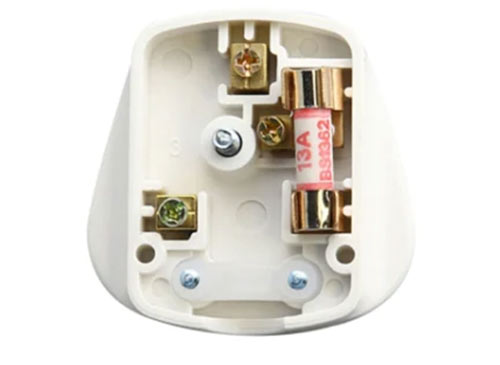
Standard 13amp fuse in a domestic plug
What are Volts?
Voltage or volts is another form of electrical measurement and is concerned with the speed that electricity flows around a circuit.
Volts are linked to what’s known as “electric potential” and this is essentially the volume of work or pressure needed to move a single electrical unit from one point to another when it’s working against an electrical field.
In the UK and indeed the whole of Western Europe, quite a few years ago the electrical supply to homes was harmonised to a new convention known as 230VAC.
At the time European supply was set to 220volts whereas UK supply was set to 240volts, so in order to settle on a voltage that could be used by all, tolerances were adjusted to all infrastructure and products so that a happy medium of 230VAC could be used by both sides.
Despite this, it’s not recommended that you use 220volt European-specific products in the UK and vice-versa, however any 230volt products should work fine in both areas.
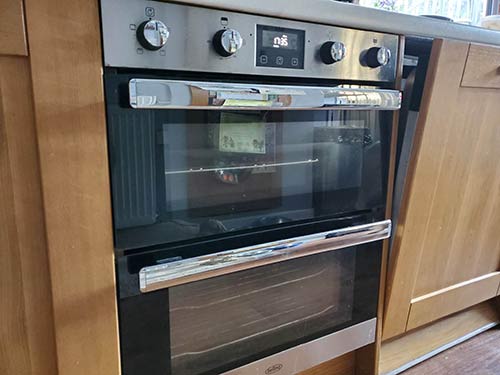
230 Volt cooker, suitable for use in Europe and the UK
What are Watts and Kilowatts?
Watts and kilowatts, out of all electrical measurements, should be the most familiar to all as it’s the measurement of the amount of electricity an appliance or object uses and due to this, especially today, is often used as a reference of how economical an appliance is.
For example a 2000 Watt electric heater will pump out a lot of heat but at the same time uses a lot of electricity to do so, whereas an 800 Watt heater may not supply quite as much heat but will use less than half the electricity of the 2000 Watt version.
It is very important to know how many Watts each piece of electrical equipment in your home draws from the power supply because there is only a finite amount of power available before things start to cook and you start tripping MCB’s and blowing fuses!
If you know how many Watts an appliance needs, you know which part of the system to get the electricity from and which fuses to apply and which size cables and wires to use to stop the fuses or wires overloading or overheating.
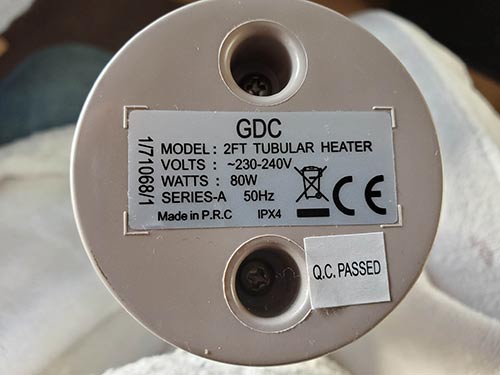
Power consumption notice on an electric heater showing wattage used
What are Ohms?
Ohms are the measurement of how much resistance there is in an electrical circuit e.g. how much friction there is that then slows down the speed at which electrons can flow.
The majority of domestic wiring in the UK uses copper cored wires (some older properties still use aluminium) and, as good as both are at conducting electricity, neither are perfect and thus have a natural amount of electrical resistance.
As we have touched on briefly above, electrical resistance is a very important safety consideration as if an appliance is trying to draw too much current down a cable that has too much resistance then ultimately this will create a lot of heat and potentially cause the cable to catch fire!
So, making sure that the resistance is low enough for the size of cable being used and the appliance it’s powering is absolutely essential.
Safety Considerations for Amps, Volts and Watts
As we have touched on with fuses, cable sizes and resistance, safety is of utmost importance all of the time when dealing with electricity. Before any work is carried out anywhere around electricity the first thing that’s done is to isolate the circuit e.g. turn off the MCB or pull out the fuse for those with fuse boxes.
When it comes to amps, volts and wattages and domestic electricity, the safety aspect revolves mostly around using the correct size fuse and electrical cable for the given circuit and the appliances it’s going to power.
It’s also essential when purchasing appliances that you only purchase those that can be used on your own particular existing circuits and infrastructure.
For example if you need to buy a new cooker or electric shower then you will need to go for one of the correct wattage to ensure it’s compatible with your existing fuse and supply cable.
As an example, should you be trying to work out the size of cooker you can buy, a cooker of 12kW or 12,000 Watts, with all rings blazing and the oven and grill firing out juicy steaks can potentially use a whole shed full of electric and should need a 52amp fuse to protect it. This is worked out by dividing 12,000 by 230 volts which equals 52 amps.
However, the chances of every part of the cooker being on at one time are quite small, but to ensure all is within tolerances a principle called The Diversity Principle is applied to the cooker and similar circuits.
For the diversity principle to be understood you must assume that the first 10 amps of current are always needed by the cooker. Despite this, probably only 30% of the remaining, available current will be used at any one time.
The actual demand will then be 10 amps (used all the time) added to 30% of the remaining 42amps (=13amps) making a total of 23 amps.
If the cooker control unit has a 13 amp socket as well as the cooker switch (see our cooker connection project) another 5 amps must be added, making 28 amps. It would then be appropriate to place the cooker on a 30 or 32 amp circuit.
How to Calculate Amps, Watts and Volts
Now that we’ve looked at exactly what amps, watts, ohms and volts are and why they are important when it comes to the electricity used in your home, it’s time to look at exactly how each can be calculated.
Calculating Amps
Working out amps is a fairly straightforward calculation and is as follows:
Amps = Watts / Volts or amps equal watts divided by volts.
Knowing how to calculate amps can be an extremely useful skill as in the case that you need to replace the fuse in a plug, but are unsure what size fuse to use, you can work it out. To find out what size fuse to use to protect an appliance you need to know the wattage and the voltage available.
Most homes in the UK are served by a 230 volt supply. The super speedy fast kettle we have in the DIY Doctor office is rated at 2500 – 3000 Watts (2.5 -3kW). We must take the larger figure for safety. 3kWatts is then divided by the voltage to give us the current rating of the cable and fuse.
3kWatts divided by 230 = 13.04amps.
3000 Watts is the maximum amount of current draw it is safe to put on a 13amp fuse in a plug.
This is how amps are worked out. If you know how many amps are available, e.g. you have a fuse, MCB or RCD in your consumer unit but you are unsure of what you can put on this circuit, you can do the calculation the other way round. Multiply the voltage by the amps and this will give you the maximum number of Watts you can place on the circuit.
If your lighting circuit at home is protected by a typical 6 amp MCB or 5 amp fuse you can multiply this by the voltage to get 1380 Watts for an MCB or 1150 Watts on a fuse.
Now you can work out how many bulbs and of what size it is safe to have in your fittings.
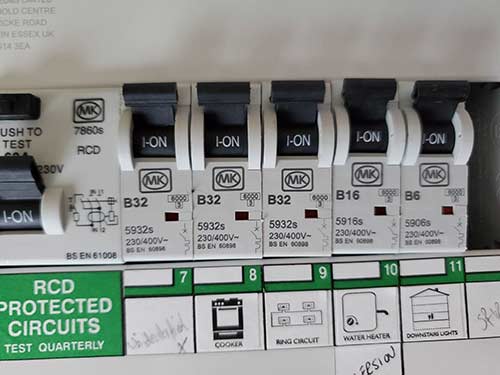
MCB’s in a consumer unit
Calculating Watts
Wattage is another very useful form of electrical measurement to know and is arguably the most commonly used. To work out the wattage of a given object is as follows:
Wattage = Amps x Volts or wattage equals amps multiplied by volts.
This is probably the most commonly used measurement due to the fact that the power output in watts is displayed on pretty much all appliances today so that you know exactly how powerful they are and how much electricity they are likely to use.
You may also be familiar with the term “Kilowatt”. This means a 1000 Watts and is simply used to stop the numbers getting too big e.g. it’s easier to say 10 kilowatts than to say 10,000 Watts.
Calculating Volts
Although slightly less commonly used by the general public, voltage is a measurement used quite a lot by trades and other electrical professionals. Working out voltage is again a straight forward calculation as follows:
Volts = Watts / Amps or voltage equals watts divided by amps.
As mentioned, voltage isn’t commonly referenced by the general public but it is used by the trades quite a bit when installing and testing electrical installations. For example voltage drop is a sizable consideration when designing electrical circuits.
Voltage drop occurs over an electrical circuit the longer it runs and the more resistance it is subjected to. Over a particularly long run the voltage could drop to the point that there isn’t enough to power the objects intended, so it’s important to be aware of voltage and how it can change.
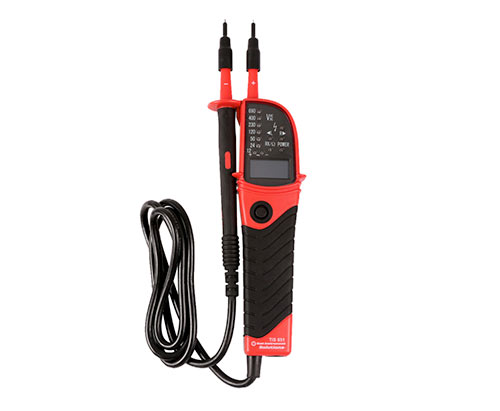
Voltage tester ideal for testing a range of voltage requirements
As you can see form the above information, amps, volts and wattage are all extremely important when it comes to the functioning and safety of all electrical systems, particularly those in a home, therefore knowing exactly what size cables, fuses and appliances can be used on a circuit is vital.

